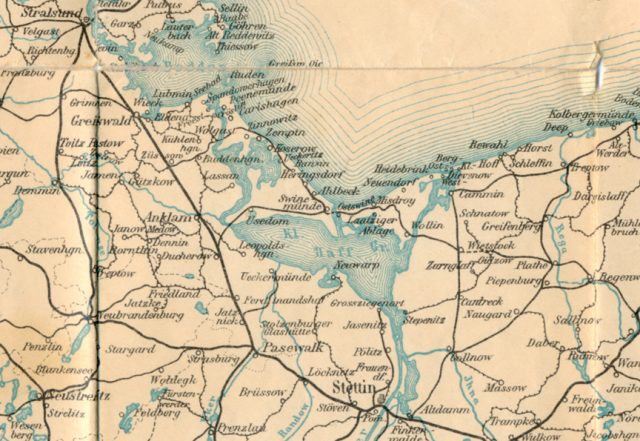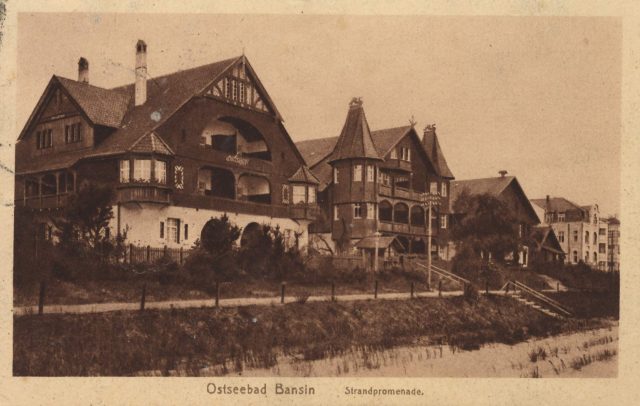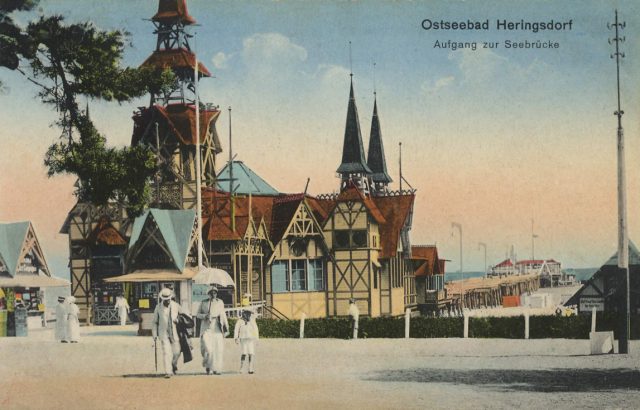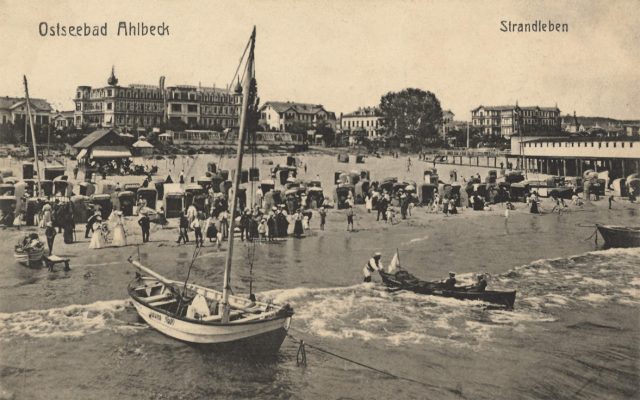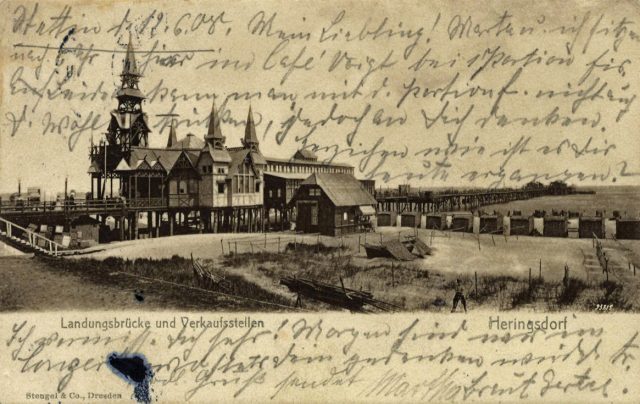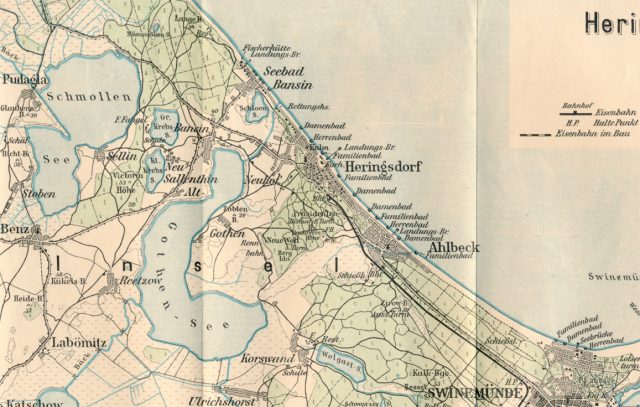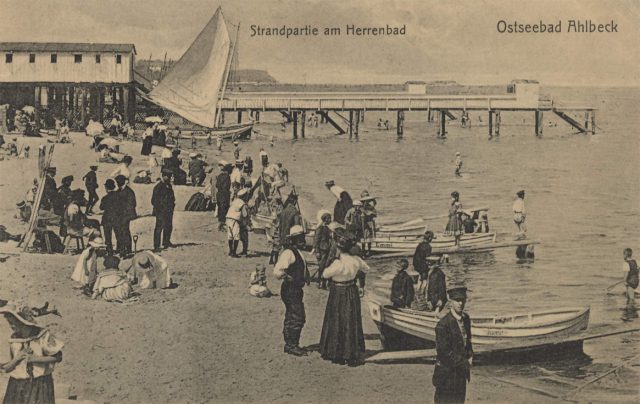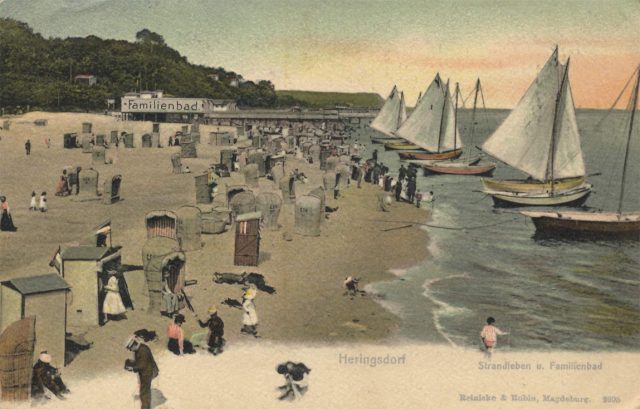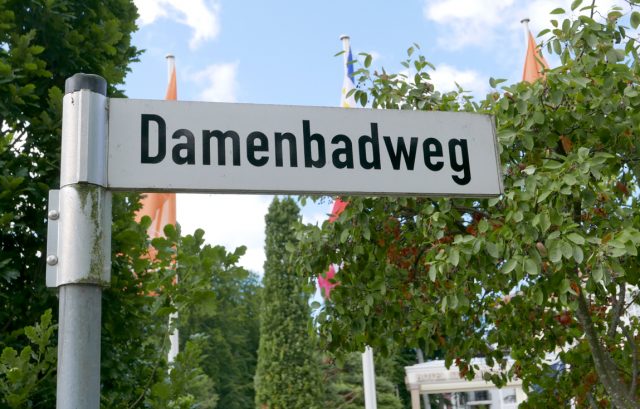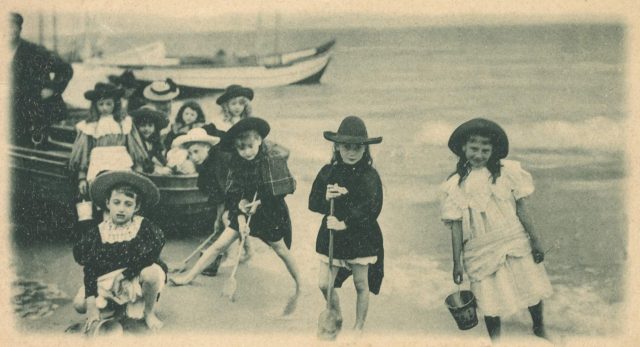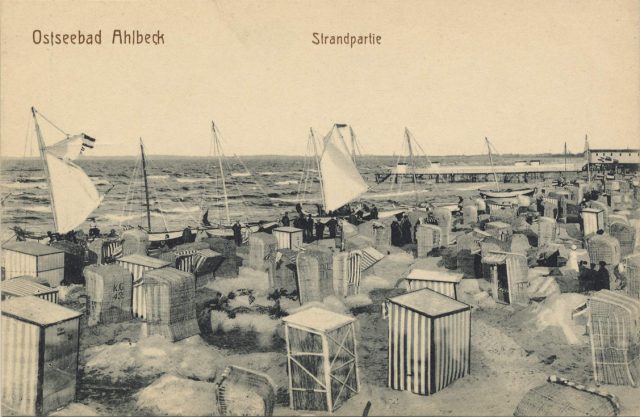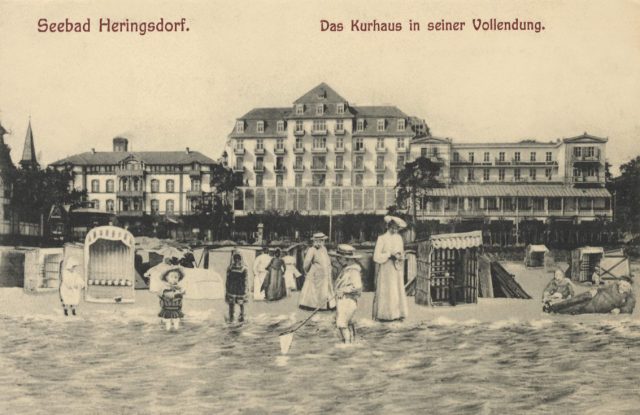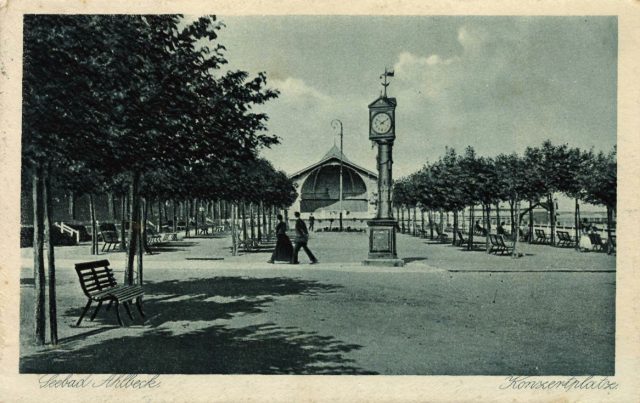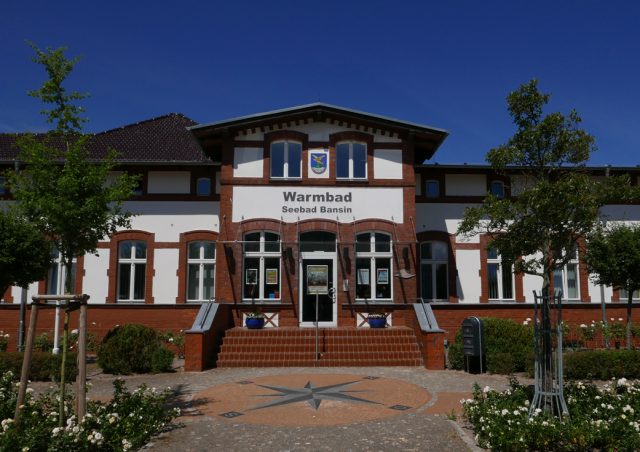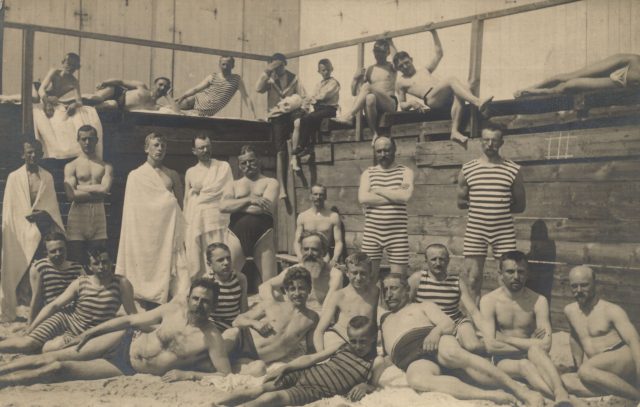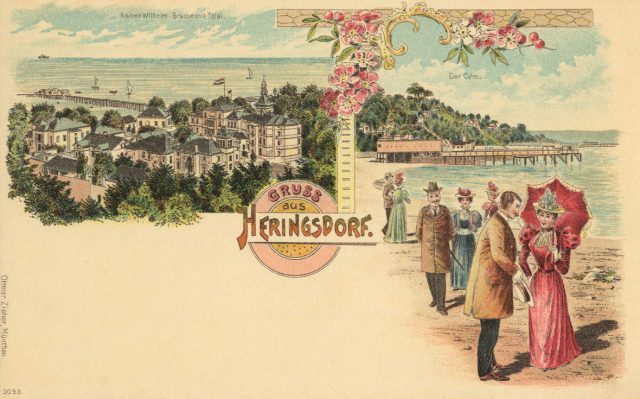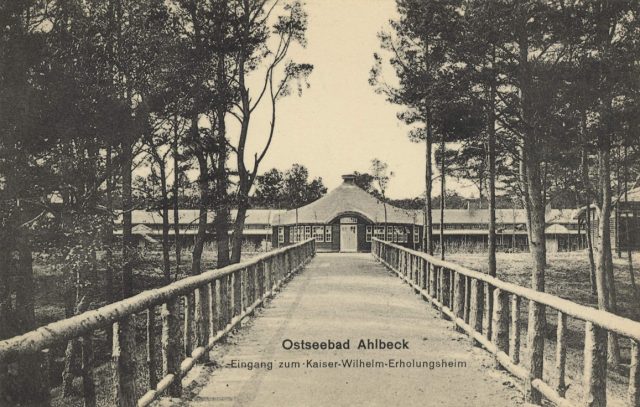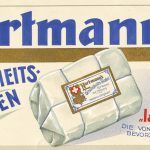Summer in Usedom – a holiday destination since belle epoque times
I am enjoying a coffee on the terrace of the Ahlbeck courtyard, the beach promenade stretches out in front of me and I briefly close my eyes. I feel the breeze from the sea, hear the horse hooves of passing carriages rattle, look after the elegant ladies passing by in their light long summer dresses, walking by themselves, in pairs, or accompanied by children or men in their summer suits.
It must have been somewhat like this in the first years of the 20th century. The beach promenade, the passing carriages as well as the beautiful hotels and villas from this period, which line the promenade, all still exist. Even the pier of Ahlbeck still stands today, which was inaugurated in 1898 and is the only remaining original pier in Germany. It is 280 meters long and stands out with its elegant pavilion with four towers.
Only today’s visitors, wearing swimming shorts, T-shirts and flip-flops, no longer look as elegant as they did back then. The Ahlbeck courtyard has retained the charm of a grand hotel of its time, even a vintage car still exists to pick up guests from the station – Ahlbeck has been connected to a rail network since 1894. However, the car does not look like it’s on the road much, even though I’m told it’s still fit to drive!
Usedom Island is a place that has been popular for summer holidays for a long time. The beach tourism began early on, in Heringsdorf in 1824, when the first hotels and guesthouses were built. Back then, it was not simple to reach the island. This changed in 1876, when the first railway line was created, first to Swinoujscie (which today belongs to Poland) and then to Heringsdorf in 1894. More and more tourists came – especially from Berlin, which is how the island got its nickname as the “bathtub of Berlin”.
In Grieben’s guidebook from 1910, it states that from Berlin, one could reach Heringsdorf by “express train” in about 3 1/2 to 4 hours. There is no longer an express train to Usedom and the journey involves train changes, which is why it takes about 4 to 4 1/2 hours today.
A more romantic alternative to reach the seaside resorts was by steamer from Stettin – until there, the trip could also be done by train.
Bansin was only connected to the railway in 1911. Before then, one would drive there from Heringsdorf by wagon. How exactly this bathing resort developed can be read here (by now there is unfortunately only the German version).
Each of the three main towns of the island, which are called “Kaiserbäder” (which means “imperial baths” in German), attracted a different class of people- the fashionable Heringsdorf the bourgeoisie, the down-to-earth Ahlbeck the middle-class citizens and Bansin, which started as a holiday destination at the end of the 19th century, was popular in military circles. More and more hotels, pensions and chic villas were built with time.
But what exactly did a vacation look like back then? A source which is nice to look at are the nostalgic postcards, which were written more frequently than today from summer resorts. Since it was forbidden to write on the back on the address page until 1906, people wrote on the front, even if that did not leave much room for the image. That certainly benefitted some people then, as it does today…
Another source are old travel guides from the time. As well as historians which are based there, who have dealt with the history of the island and the spa resorts in detail and who I would like to thank for their support in the creation of this article.
Naturally, many postcards and old photographs from Usedom have beach images on them. They show laughing children in sailor suits with their mothers, which are fully dressed, and the fathers in their summer suits. There are also “frivolous” postcards and caricatures with laughing young girls in sexy bathing suits- while everything is covered, they are quite figure-accentuating.
However, one was not allowed to swim in the sea. There were bathing establishments for this, at first (in the last third of the 19th century) separate ones for ladies and men. The ladies’ bath was at one end of the seaside resort and the men’s bath at the other. In Heringsdorf there is still a “path to the lady’s bath”, which most likely led to the bath. To find out more on how exactly people bathed back then, I met Hans-Ulrich Bauer. Born in Heringsdorf, he has traveled a lot in the world, and has been living in Usedom for a few years now, where he has worked intensively on the history of the Kaiserbäder and the island.
He has many funny stories to tell about the formerly separated bathing facilities. For instance, there were the so-called “Kieker”, which were gentlemen who liked to watch the bathing ladies in the ladies’ pool. Apparently, it happened quite frequently, as it was sometimes forbidden for men to come any closer than 75 meters to the ladies’ bathhouse. In Zinnowitz, a sign declared that “in case of transgression, you are to pay a penalty of 9 marks!”.
The staff was also almost exclusively female and male lifeguards had to be married. In the men’s bathing facilities, the attitude was more relaxed and there was also less staff, especially less life guards– while there were 14 guards in the ladies’ facilities, there were only 9 in the men’s.
However, families had not really been considered when the bathing facilities were separated. They were, so to speak, torn apart – the mother and her children went to the ladies’ bathhouse, the father (and older sons) to the men’s. A solution was introduced in 1902 in the seaside resorts, when family bathing facilities were built. Individual gentlemen without a family accompanying them were not allowed to access them – “kieken” from the inside did not work.
The Grieben’s travel guide from 1910 says the following about the bathing establishments in Heringsdorf:
“The bathing facilities are good. There are two ladies’ baths, one in the west with 30 cabins, the other in the east with 23 cabins, a men’s bath with 25 cabins and two family bathing facilities with about 300 cabins in total. Far-reaching footbridges allow bathing in the deep water, the bathing area is excellent. ”
The bathing establishments were directly on the beach and built on poles into the sea in the shape of a horseshoe. To protect against prying eyes (especially the “kiekers”), high wooden walls were erected. One changed in the individual cabins, taking off one’s long clothes or suits and putting on one’s swimwear, with which one bathed in the sea – we’ll have a closer look at what those looked like later. The family bathing establishments were designed in a way that one could bathe safely or meet one’s family in the water (within the family facilities the cabins were once again separated according to genders).
After the bath, one changed once more and then went back to the beach, where the children could play by the water in light clothing. It was already pretty crowded on the beach for the season of July / August back then, as the pictures demonstrate.
The baths cost an entrance fee and in addition, there were different bathing times during the day: in Heringsdorf, it was from 7-9 o’clock in the morning for the early birds and in the afternoon from 16-18 o’clock for 20 pfennig per adult; for the late risers it ws from 9-14 o’clock for 50 pfennigs. And apropos fees: even a spa tax already existed then.
But you got a lot for that:
“Only those with spa cards or day passes are entitled to visit the reading, playing and music rooms in the Kursaal and the concerts.” Spa concerts were held several times a day; in Heringsdorf, for instance, they took place in the orchestra pavilion of the Kursaal or on the Kaiser Wilhelm Bridge, which was the name of the pier.
There were also sports facilities: “In the forest, south of the road leading to Neuhof, there are lawn tennis and croquet playgrounds and a highly frequented gym. There are several bowling alleys by the forestry. ”
From the twenties onwards the bathing establishments became superfluous. The seaside resorts allowed people to swim for free in the sea, directly from one’s beach chair.
In Heringsdorf, a twelve-meter-high water slide was built in the facilities which had previously been used for families to bathe in, where the visitors could slide into the sea. This attraction meant the family bathing establishment remained in use- many other bathing facilities were demolished, as they no longer served a purpose. After the war, the entrance area of this bathing facility was still used as a ball room, however, it burned down in the early sixties.
When the sea was too cold (which certainly happened frequently in the Baltic Sea), travellers could use the heated public baths in the health resorts. Here, one could wash oneself – a “wash for one person” cost 25 Pfennig according to Grieben’s guidebook – and besides the “sea or fresh water baths” that were offered, there were also “sol, moor” and even “partial sand baths” (whatever that meant). In addition, medical services such as “inhalations” and “orthopaedics” were offered in the spa and even spa services (which were not called that at the time) such as “hydrotherapy” and massage – naturally, one had to pay a “special rate” for these.
So, what did people wear to bathe in, and did they wear anything at all? Naturally! Even at the beginning of the 20th century, there were already people following the trend of “returning to nature” and nude bathing, called “Swedish bathing”, was popular amongst them.
This wouldn’t have been a problem in the separate bathing facilities, but it was frowned upon in society. Thus, the ladies wore a bathing suit for bathing, often with long or wide pants and even black bathing stockings. In the course of the ’10s, the impractical pants slowly disappeared and were replaced by bathing suit which still covered the thighs. Later, the swimsuits became shorter and more figure-enhancing. Bikinis were only worn after World War II (not only in the Baltic Sea), after they were invented in 1946.
Everything was a little simpler for the men, they wore short swimming trunks in the men’s bathing establishments. However, this clothing was not allowed in the family bathing facilities – here one had to wear a swimsuit made of cotton, usually with red or blue and white stripes.
And nude bathing? As the trend of “returning to nature” became more popular in the 1920s, the Prussian authorities issued the so-called “Zwickelerlass”, which forbade nude bathing.
Additionally, in the GDR, there was an attempt to ban nudism on the beach, but it failed, and finally people were allowed nude bathing on certain sections of the beach, which were designated as nudist beaches. Today, these different sections still exist and there is peaceful coexistence between the visitors.
And when were beach chairs introduced? The first beach chair was made by the Rostock basket maker Wilhelm Bartelmann for a rheumatism lady. The chair attracted attention on the beach and people ordered more of these seats from Bartelmann. He continued developing them, with footrests, little tables, and so on, and finally as the two-seater we know today. His wife opened the first beach chair rental facility in Warnemünde in 1883 (Wikipedia). As early as the beginning of the 20th century, there were beach chairs on the Baltic Sea and North Sea beaches that are very similar to todays. And they are still popular all around the world.
In addition, beach huts could be rented for a week. The cheaper alternative – beach castles – have been around for a long time and the freer life on the beach became, the more popular they became.
Apart from having fun bathing, a summer holiday stay in the seaside resorts was also an important social event. Who lived in the best hotel, had the largest and chicest villa – whether as their own summer residence or as a place they rented?
One strolled along the promenades and piers with various shops and cafes, met for dinner and looked for the right husband for one’s daughter of marriageable age, since the summer resorts were also a marriage market. During the winter season there were balls and festivals in the big cities where young people met – whether out of love or arrangement – so in the summer there were various other places where people met and made connections. The Kaiserbäder undoubtedly belonged to those places!
Speaking of the Emperor: Of course, Wilhelm II was a guest in Usedom several times. Partly, he went to visit a certain lady, the owner of Villa Staudt – here (only in German) you can read more about the history of the villa and its inhabitants. He also went to inaugurate a children’s home that still exists today. In the summer, the imperial couple travelled regularly to the “Nordland”, a province of Norway and then made a stop on the way back to Usedom. Alternatively, the Kaiser came from the Kieler Woche, which he visited regularly, for a detour to Usedom.
The beautiful villas and hotels, which are still preserved from this period, were unused in the GDR era. Fortunately, many of them once again shine in their former splendor, and one can well imagine the flair of that time.
They are not all built in the same style – one can find alpine charm, Scandinavian comfort, classicist rigor and, of course, the architectural style of the time, the Art Nouveau, alongside buildings that are a mixture of different styles, since one let oneself be inspired and inspired others. Today, the term “resort architecture” summarizes this well.
A peculiarity, which was common in but not limited to Usedom, were wooden houses, which were built in prefabricated construction method. This article (only in German) recounts of two Bansin villas that were built in this style.
Villen auf Usedom - Impressionen der Bäderarchitektur
In any case, there was something for everyone in the Kaiserbäder: whether one chose the sophisticated Heringsdorf (“which has developed into a world-famous bathing establishment in recent decades”), the casual Bansin (“there is no excessive toilet luxury here”) or the aspiring Ahlbeck ( “housing prices are now generally not much cheaper than in Heringsdorf”) – a degree of wealth was probably a prerequisite to spend the summer here, but there were simple as well as luxurious pensions, hotels and places of amusement. (The citations in brackets are from our Grieben’s travel guide from 1910).
Even today, the seaside resorts are popular – not only because of their historical charm, but also because of the beautiful beaches, the Baltic Sea and the healthy sea air.
And if you feel like visiting this place, don’t forget to take a sand bath before the going into the ocean (if only a partial one) and (still today) a spa card – ours was actually checked on the beach.
Have fun on beach and swimming,
Yours Grete


